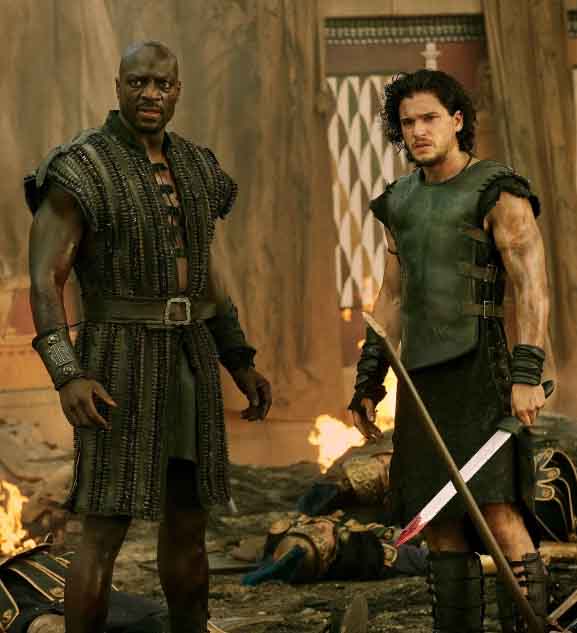The eruption of Mount Vesuvius that destroyed the Roman Empire city of Pompeii in 79AD provides the backdrop for an epic story of revenge, love and political intrigue in the film “Pompeii.” People have been telling the story of the devastation of this Bay of Naples city since the Ancient Roman Pliny the Younger wrote a letter about what he witnessed from a distance over 1,900 years ago. This time, director Paul W. S. Anderson (Resident Evil, The Three Musketeers) goes heavy on the action and special effects to make a historical drama that even someone challenged with an attention deficit can’t lose interest. Though the emotionality of the love story comes off a little flat, the rendering of the actual explosive power and destruction of the volcano itself is absolutely astounding.
In Pompeii, a young boy named Milo witnesses the massacre of his family and Celtic tribe at the order of a conquering Roman named Corvus (Kiefer Sutherland). That boy grows up to be a fierce gladiator slave, played by Kit Harington (“Game of Thrones”), who’s still angry over everything he’s lost. In a plot point borrowed from Gladiator, Milo is taken from the outer provinces of the Roman Empire to fight in a more popular arena. Milo’s journey to Pompeii proves very fateful, as he’s not only quickly able to capture the heart of the aristocratic Cassia, played by Emily Browning (Sucker Punch), but is soon slated to take on the massively built, champion gladiator Atticus (Adewale Akinnuoye-Agbaje) in the arena. Atticus is incredibly intimidating, but still manages to draw sympathy from the viewer. The true villain reveals himself with the now Senator Corvus, who has designs on both the city and more importantly, on Cassia. All of these story lines are playing out when Vesuvius explodes, putting the mere possibility of survival into question for everyone.
 English born Harrington has already proven his appeal with the popularity of his character “Jon Snow” in HBO’s much-adored Game of Thrones. Here in Pompeii, however, Harrington’s character Milo is set at the center of three starkly different storylines to varying degrees of narrative success. Sutherland’s Senator Corvus is stuck so vehemently in villainy, that his conflict with Milo never really moves past the “good guy”/“bad guy” relationship. As for the love story, Pompeii was originally pitched as Titanic under a volcano. On its surface this description makes sense. It is the story of star-crossed lovers set against a tragic event. Despite the best efforts of Harrington and Browning, the central romance is one of the weaker elements of the film. There doesn’t seem to be much to connect Milo and Cassia beyond attraction. The film takes more time developing the relationship between Milo and Atticus, who were set to kill each other, but instead find camaraderie in the most unlikely of places. Akinnuoye-Agbaje, who is also English, is better known in television for award winning performances in Oz and Lost and here he seems very comfortable in a major role in a feature. By way of Harrington and Akinnuoye-Agbaje’s performances we are able to see a real progression in the kinship of Milo and Atticus.
English born Harrington has already proven his appeal with the popularity of his character “Jon Snow” in HBO’s much-adored Game of Thrones. Here in Pompeii, however, Harrington’s character Milo is set at the center of three starkly different storylines to varying degrees of narrative success. Sutherland’s Senator Corvus is stuck so vehemently in villainy, that his conflict with Milo never really moves past the “good guy”/“bad guy” relationship. As for the love story, Pompeii was originally pitched as Titanic under a volcano. On its surface this description makes sense. It is the story of star-crossed lovers set against a tragic event. Despite the best efforts of Harrington and Browning, the central romance is one of the weaker elements of the film. There doesn’t seem to be much to connect Milo and Cassia beyond attraction. The film takes more time developing the relationship between Milo and Atticus, who were set to kill each other, but instead find camaraderie in the most unlikely of places. Akinnuoye-Agbaje, who is also English, is better known in television for award winning performances in Oz and Lost and here he seems very comfortable in a major role in a feature. By way of Harrington and Akinnuoye-Agbaje’s performances we are able to see a real progression in the kinship of Milo and Atticus.
 The Vesuvius eruption devastated the city of Pompeii at an alarming speed. Besides the ash and pumice that were discharged, there was also six of what’s called pyroclastic surges or “glowing avalanches,” which can move as fast as 450 mph and will destroy everything they come in contact with. This creates an interesting dilemma for Anderson and screenwriters, Janet and Lee Batchler and Michael Robert Johnson, as once the volcano erupts there is no more time for any kind of story or character development, all actions must now be informed by impending doom. If the eruption were brought out too early, this would make for a very short movie and at 98 minutes, it’s already pretty short for an epic film. So the filmmakers go about delaying the inevitable as long as possible. Since this is still an action film, most of the delaying comes from multiple action sequences among the gladiators. These scenes would probably seem more repetitive if they weren’t skillfully shot and staged. It should come as no shock that the director of three Resident Evil movies, using a trusted collaborator in director of photography in Glen MacPherson (Resident Evil: Retribution, The Three Musketeers), would be able to bring some exciting action to the screen. However, the main thing the film sets out to do before the eruption, is arrange the character conflicts, so that they can be efficiently resolved in the climax and before the volcano wipes everything away.
The Vesuvius eruption devastated the city of Pompeii at an alarming speed. Besides the ash and pumice that were discharged, there was also six of what’s called pyroclastic surges or “glowing avalanches,” which can move as fast as 450 mph and will destroy everything they come in contact with. This creates an interesting dilemma for Anderson and screenwriters, Janet and Lee Batchler and Michael Robert Johnson, as once the volcano erupts there is no more time for any kind of story or character development, all actions must now be informed by impending doom. If the eruption were brought out too early, this would make for a very short movie and at 98 minutes, it’s already pretty short for an epic film. So the filmmakers go about delaying the inevitable as long as possible. Since this is still an action film, most of the delaying comes from multiple action sequences among the gladiators. These scenes would probably seem more repetitive if they weren’t skillfully shot and staged. It should come as no shock that the director of three Resident Evil movies, using a trusted collaborator in director of photography in Glen MacPherson (Resident Evil: Retribution, The Three Musketeers), would be able to bring some exciting action to the screen. However, the main thing the film sets out to do before the eruption, is arrange the character conflicts, so that they can be efficiently resolved in the climax and before the volcano wipes everything away.
Which brings us to the crowning achievement of the film – the volcano. It’s obvious that Anderson and his visual effects crew, including visual effects supervisor, Dennis Berardi, took great pains to create a portrayal of the eruption that was both accurate and mesmerizing. Pompeii was shot in 3-D and Andersongraciously uses the 3-D as a utility instead of a gimmick. For instance, those pyroclastic surges mentioned earlier are hauntingly depicted crawling over the city in a wide shot that’s terrifying and captivating. The use of 3-D is wisely used to give some sense of the thrust and imminent danger of this violent act of nature. If you’ve ever seen a close-up picture of a volcano, you know the otherworldly quality they already possess and what I believe Anderson did here was imbue in Pompeii a respectful artistry to nature.
So whether you want to see gladiators battle it out in the arena, be surrounded by fire and ash in a crumbling city or just see a meticulously crafted visualization of an historic event, Pompeii delivers.
By Adrian Vina














